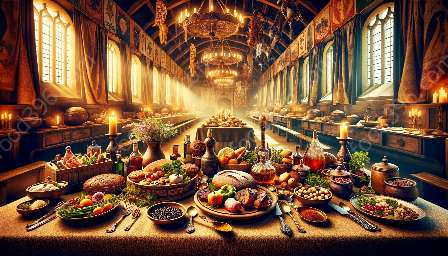Medieval Europe was a period of rich culinary traditions and regional variations, reflecting the diverse cultural influences and resources available across different territories. The cuisine of this era was shaped by historical, social, and geographical factors, leading to a fascinating tapestry of flavors, ingredients, and cooking techniques.
Historical Context
During the medieval period, European cuisine underwent significant transformations, influenced by the interaction of various civilizations, including the Byzantine, Islamic, and Norse cultures. The culinary heritage of each region was impacted by trade, conquests, and the spread of new foodstuffs, resulting in an array of unique dishes and cooking methods.
Regional Variations
Medieval Europe comprised a wide array of regions, each with its own distinct culinary traditions. The food customs in the Mediterranean region, for instance, were heavily influenced by the abundance of olive oil, citrus fruits, and an assortment of spices, resulting in flavorful and aromatic dishes.
In Northern Europe, colder climates and limited access to certain ingredients contributed to heartier and more preserved foods, such as smoked meats, pickled vegetables, and fermented dairy products. The reliance on these preservation techniques shaped the culinary identity of Northern European countries.
Eastern European cuisine, characterized by the use of grains, root vegetables, and hearty soups, reflected the agricultural practices and climatic conditions prevalent in this region. The incorporation of Slavic, Baltic, and Hungarian culinary traditions added depth and complexity to the culinary landscape of Eastern Europe.
Influential Ingredients and Cooking Techniques
The ingredients and cooking techniques employed in medieval Europe varied significantly from region to region, contributing to diverse flavor profiles and culinary innovations. Common staples, such as bread, meat, fish, vegetables, and dairy products, were prepared in distinct ways across different territories.
Spices played a pivotal role in medieval European cuisine, with the spice trade facilitating the introduction of exotic flavors, such as cinnamon, cloves, and saffron, into the culinary repertoire. Additionally, the use of herbs, both for flavoring and medicinal purposes, was widespread, contributing to the development of herbal blends and aromatic seasonings.
Cooking methods also differed based on regional practices and available cooking implements. Roasting, boiling, stewing, and baking were prevalent methods, with various utensils and cooking vessels contributing to the overall diversity of dishes prepared.
Legacy and Modern Influences
The culinary traditions and regional variations of medieval Europe continue to exert influence on modern cuisine, with many traditional recipes and flavor combinations persisting through the centuries. The impact of medieval cooking techniques can be observed in contemporary culinary practices, showcasing the enduring legacy of this historical period.
Exploring the diverse culinary traditions and regional variations in medieval Europe offers valuable insights into the historical significance of food and its role in shaping cultural identities. From the elaborate feasts of royalty to the hearty meals of the common people, the cuisine of this era provides a window into the past, enriching our understanding of culinary history and its enduring impact on the way we eat today.

